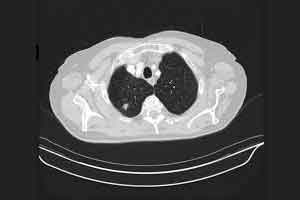- Home
- Editorial
- News
- Practice Guidelines
- Anesthesiology Guidelines
- Cancer Guidelines
- Cardiac Sciences Guidelines
- Critical Care Guidelines
- Dentistry Guidelines
- Dermatology Guidelines
- Diabetes and Endo Guidelines
- Diagnostics Guidelines
- ENT Guidelines
- Featured Practice Guidelines
- Gastroenterology Guidelines
- Geriatrics Guidelines
- Medicine Guidelines
- Nephrology Guidelines
- Neurosciences Guidelines
- Obs and Gynae Guidelines
- Ophthalmology Guidelines
- Orthopaedics Guidelines
- Paediatrics Guidelines
- Psychiatry Guidelines
- Pulmonology Guidelines
- Radiology Guidelines
- Surgery Guidelines
- Urology Guidelines
Guidelines for Management of Pulmonary Nodules Found Incidentally on CT Scan

At times treating doctors come across CT scan reports in which “according to the Fleischner Society guidelines…” appears during the discussion of an incidentally found small pulmonary nodule. These widely cited guidelines, published initially in 2005, give recommendations on follow-up intervals for repeat imaging. Now, the Society has published a revision.
Salient points
- The guidelines address pulmonary nodules detected incidentally on CT scans ordered for other reasons. They do not apply to nodules found on CT scans ordered explicitly for lung cancer screening nor to immunosuppressed patients or patients with known cancer.
- The guidelines include two sets of recommendations, one for solid nodules and one for subsolid nodules (i.e., ground glass or partly solid). Nodules are classified by size (<6 mm, 6–8 mm, and >8 mm); by whether a single nodule or multiple nodules are detected; and by whether the nodule, the patient, or both are considered low-risk or high-risk. Risk factors include nodule morphology, nodule location, the presence of emphysema or fibrosis, smoking history, and family history.
- Nodules are divided into 18 categories that reflect various combinations of size, morphology, and risk factors. Follow-up recommendations vary from “no routine follow-up” (for single low-risk nodules smaller than 6 mm) to “consider CT at 3 months” (for selected larger nodules). Between these extremes, 6- or 12-month follow-up scans are recommended in specified categories. For some nodules larger than 8 mm, tissue sampling or combined positron emission tomography plus CT should be considered.
For more details click on the link: http://www.jwatch.org/na43993/2017/05/04/management-pulmonary-nodules-found-incidentally-computed
Next Story
NO DATA FOUND

Disclaimer: This site is primarily intended for healthcare professionals. Any content/information on this website does not replace the advice of medical and/or health professionals and should not be construed as medical/diagnostic advice/endorsement or prescription. Use of this site is subject to our terms of use, privacy policy, advertisement policy. © 2020 Minerva Medical Treatment Pvt Ltd